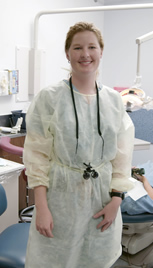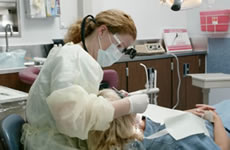Personal experience with ectodermal dysplasia leads to career in dentistry

Photo courtesy of the University of Texas Health Science Center at San Antonio |
At first, it might seem odd that someone who had to spend a lot of time in the dental chair would choose to become a dentist. But for a young person who was already interested in science, health, and helping others it seemed like the obvious choice. "I never really thought about doing anything else," says Dr. Sarah Tevis.
A former patient in an NIDR (now NIDCR) dental implant study, Tevis became a dentist and is now a resident in the Advanced Education in General Dentistry Residency Program at the University of Texas Health Science Center at San Antonio. She and her colleagues help those with the most complex needs such as medically compromised patients who require extensive dental treatment.
Recently, she won a "Remarkable Woman Award" sponsored by Johnson & Johnson for her contributions in the fields of health and science. "My mom wrote an essay about why she thought I should receive the award," Tevis says. Tevis was one of four national winners who received $7,000 and a trip to New York City to appear on the TV show, "The View." Says Tevis, "It was an honor to be selected."
The 27-year-old Waco, Texas, native says her personal experiences are what led her to help others. Tevis was born with one of the ectodermal dysplasia syndromes (ED), a group of hereditary disorders that result in malformed or missing teeth, hair, nails, and a decreased ability to sweat. Although she had baby teeth, she only developed a few, poorly formed permanent teeth and she has some decreased ability to sweat. "When I was missing teeth, I didn't smile very much," she says. "It can really hurt your self-esteem." Her pediatric dentist, Dr. Brad Willis, diagnosed the ED and referred her to the NIDR. "He said he knew our family would be in good hands there." Tevis says Willis was the first dentist who influenced her career choice.
NIDR Implant Study
At the age of 12, Tevis traveled with her mother to NIH to participate in a study of dental implants. The study was the first to use implants in pre-teens and teenagers with ED. "We definitely thought that implants could improve quality of life for these youngsters," said Dr. Albert Guckes, former NIDR deputy clinical director and now an a ssociate professor in the Department of Prosthodontics at the University of North Carolina School of Dentistry.
The dental researchers used titanium endosseous screw implants, which can each hold one or more prosthetic teeth. Two surgical procedures are required to place these implants. First, the oral surgeon cuts through the top of the gum tissue to expose the jawbone. Small holes are drilled into the bone, and a screw implant is placed in each hole. The gums are closed and allowed to heal. During the following three to six months, the implants are osseointegrated, a process in which the bone grows to surround the implant and anchors it in place. In a second surgery, an incision is made to expose the implants and a small post is put on top of each one. Attaching the prosthetic teeth to the posts is the final phase of the process.
In the NIDR study, researchers placed implants only in the front part of the bottom jaw. According to Guckes this area of the jaw stops growing before other areas, where significant growth is still expected. The researchers found that in almost all cases the implants successfully osseointegrated. "And they did improve quality of life for our patients," Guckes said.
Tevis received six implants in her lower jaw. "Dr. Al Guckes was my dentist and one of the reasons I decided to practice dentistry," she says. "I always felt like an important person to him, not just a patient. He's now a good friend and mentor and we keep in touch through our work with the National Foundation for Ectodermal Dysplasias."
Tevis eventually had implants placed in her upper jaw at Baylor College of Dentistry.
She attended college at Texas Tech University in Lubbock and after graduating in 1998 went on to dental school.
Trying Out Research
During her first year in dental school at the University of Texas Health Science Center at San Antonio (UTHSCSA), Tevis met Dr. Mary MacDougall, a professor in the Department of Pediatric Dentistry and Associate Dean for Research at UTHSCSA. A long-time NIDCR grantee, MacDougall studies the molecular mechanisms of normal tooth development as well as abnormal tooth development associated with human genetic diseases. Tevis decided she'd like to conduct research in MacDougall's lab. "I asked her if I could start my own research project," says Tevis. "She said 'yes' and mentored me through it."
Not surprisingly, the research focused on ED. Tevis has the autosomal dominant form of the condition, meaning a single, abnormal gene on one of the autosomal ("non-sex") chromosomes from either parent had caused her ED. Her goal was to identify the location of that gene, so she enlisted her family's help. "We collected blood samples from my immediate family members to analyze their DNA. And, no, I didn't have to draw the blood!" she says, sounding relieved. Although she and her co-workers eliminated several chromosomes from consideration, they did not find the gene's exact location. But the experience was interesting, Tevis said, and reinforced how important research is for finding answers that will ultimately improve health.
Sarah Tevis, D.D.S.

Photo courtesy of the University of Texas Health Science Center at San Antonio |
In June of 2004 Sarah Tevis will be finished with her residency program. What are her plans then? "I'm still trying to figure that out," she says laughing. "I would like to join an established practice and learn about the business end of dentistry. One day I'd like to become a partner in a practice or buy one," she says. "Some day, I might think about teaching or clinical research part time."
One thing she is sure of is that she'll continue her work on the board of the National Foundation for Ectodermal Dysplasias (NFED), which helps those with ED learn about and live with the disorder. She speaks at NFED conferences and talks with families referred to her by the organization.
"The challenge of my personal experiences has motivated me to do everything I can to help others have a smile they can be proud of," says Tevis. "I would be honored if people with ED sought me out. I would love to help them."
For additional information please see: